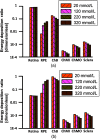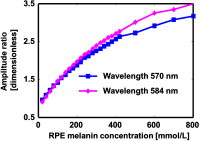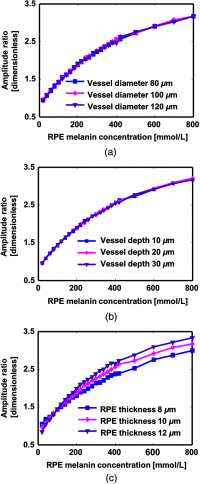Monte Carlo investigation on quantifying the retinal pigment epithelium melanin concentration by photoacoustic ophthalmoscopy
- PMID: 26469564
- PMCID: PMC4881288
- DOI: 10.1117/1.JBO.20.10.106005
Monte Carlo investigation on quantifying the retinal pigment epithelium melanin concentration by photoacoustic ophthalmoscopy
Abstract
The retinal pigment epithelium (RPE) melanin plays an important role in maintaining normal visual functions. A decrease in the RPE melanin concentration with aging is believed to be associated with several blinding diseases, including age-related macular degeneration. Quantifying the RPE melanin noninvasively is therefore important in evaluating the retinal health and aging conditions. Photoacoustic ophthalmoscopy (PAOM), as an optical absorption-based imaging technology, can potentially be applied to measure variations in the RPE melanin if the relationship between the detected photoacoustic (PA) signal amplitudes and the RPE melanin concentrations can be established. In this work, we tested the feasibility of using PA signals from retinal blood vessels as references to measure RPE melanin variation using Monte Carlo (MC) simulation. The influences from PAOM axial resolution, the depth and diameter of the retinal blood vessel, and the RPE thickness were examined. We proposed a calibration scheme by relating detected PA signals to the RPE melanin concentrations, and we found that the scheme is robust to these tested parameters. This study suggests that PAOM has the capability of quantitatively measuring the RPE melanin in vivo.
Figures







Similar articles
-
Simultaneous in vivo imaging of melanin and lipofuscin in the retina with photoacoustic ophthalmoscopy and autofluorescence imaging.J Biomed Opt. 2011 Aug;16(8):080504. doi: 10.1117/1.3606569. J Biomed Opt. 2011. PMID: 21895304 Free PMC article.
-
Accuracy of retinal oximetry: a Monte Carlo investigation.J Biomed Opt. 2013 Jun;18(6):066003. doi: 10.1117/1.JBO.18.6.066003. J Biomed Opt. 2013. PMID: 23733019 Free PMC article.
-
Integrated photoacoustic ophthalmoscopy and spectral-domain optical coherence tomography.J Vis Exp. 2013 Jan 15;(71):e4390. doi: 10.3791/4390. J Vis Exp. 2013. PMID: 23354081 Free PMC article.
-
Photoacoustic ophthalmoscopy for in vivo retinal imaging: current status and prospects.Ophthalmic Surg Lasers Imaging. 2011 Jul;42 Suppl(0):S106-15. doi: 10.3928/15428877-20110627-10. Ophthalmic Surg Lasers Imaging. 2011. PMID: 21790106 Free PMC article. Review.
-
[Pathophysiology of macular diseases--morphology and function].Nippon Ganka Gakkai Zasshi. 2011 Mar;115(3):238-74; discussion 275. Nippon Ganka Gakkai Zasshi. 2011. PMID: 21476310 Review. Japanese.
Cited by
-
Quantifying melanin concentration in retinal pigment epithelium using broadband photoacoustic microscopy.Biomed Opt Express. 2017 May 4;8(6):2851-2865. doi: 10.1364/BOE.8.002851. eCollection 2017 Jun 1. Biomed Opt Express. 2017. PMID: 28663911 Free PMC article.
-
Imaging retinal melanin: a review of current technologies.J Biol Eng. 2018 Dec 4;12:29. doi: 10.1186/s13036-018-0124-5. eCollection 2018. J Biol Eng. 2018. PMID: 30534199 Free PMC article. Review.
-
The Effect of Retinal Melanin on Optical Coherence Tomography Images.Transl Vis Sci Technol. 2017 Apr 3;6(2):8. doi: 10.1167/tvst.6.2.8. eCollection 2017 Apr. Transl Vis Sci Technol. 2017. PMID: 28392975 Free PMC article.
-
Retinal oximetry in humans using visible-light optical coherence tomography [Invited].Biomed Opt Express. 2017 Feb 7;8(3):1415-1429. doi: 10.1364/BOE.8.001415. eCollection 2017 Mar 1. Biomed Opt Express. 2017. PMID: 28663838 Free PMC article.
-
Dual-band optical coherence tomography using a single supercontinuum laser source.J Biomed Opt. 2016 Jun 1;21(6):66013. doi: 10.1117/1.JBO.21.6.066013. J Biomed Opt. 2016. PMID: 27304421 Free PMC article.
References
-
- Berendschot T. T., et al. , “Influence of lutein supplementation on macular pigment, assessed with two objective techniques,” Invest. Ophthalmol. Visual Sci. 41(11), 3322–3326 (2000).IOVSDA - PubMed
-
- Landrum J. T., Bone R., Kilburn M. D., “The macular pigment: a possible role in protection from age-related macular degeneration,” Adv. Pharmacol. 38, 537–556 (1996). - PubMed
-
- Hyman L. G., et al. , “Senile macular degeneration: a case-control study,” Am. J. Epidemiol. 118(2), 213–227 (1983).AJEPAS - PubMed
Publication types
MeSH terms
Substances
Grants and funding
LinkOut - more resources
Full Text Sources
Other Literature Sources

